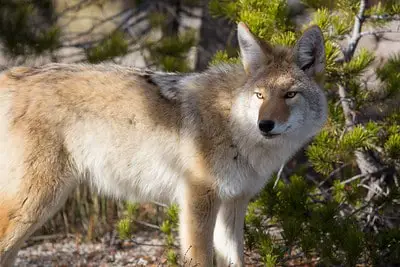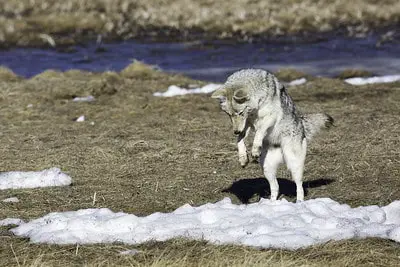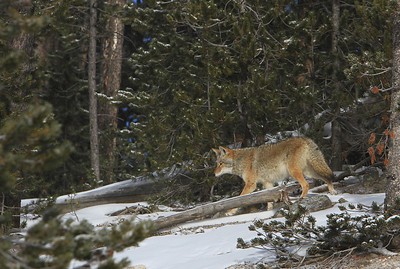Hunting coyotes in Wisconsin? Wisconsin is known by most folks for three things big bucks, cheese, and tons of snow. But it also has a massive share of North America’s coyote population and a generous, year-round season to take advantage of.

Coyote hunting is permitted day and night all year in Wisconsin. A license is required. The use of lights and infrared riflescopes at night is illegal except for at the point of kill. Electronic callers, suppressors, and thermal riflescopes are permitted.
If you are interested in hunting coyotes in Wisconsin, there a hand full of rules and regulations you should understand. Please check for updates before you make your first Wisconsin coyote stand. Buy a Wisconsin hunting license here: https://gowild.wi.gov/.
Check out all the Wisconsin hunting seasons.
Related: Learn the rules for hunting fox in Wisconsin.
Related: Learn the rules for hunting bobcats in Wisconsin.
Rules and regulations for hunting coyotes in Wisconsin.
What does point of kill mean?
Before we proceed any further, let’s get one thing out of the way.
You cannot use lights for hunting at night in Wisconsin except at the “point of kill.”
Point of Kill means the location at which a light is used to illuminate and kill a wild animal whose position or location is known by the hunter. Simply put, you cannot use a light at night to scan, search for, or locate coyotes in Wisconsin.
Related: What are the two favorite sounds of most coyote hunters? Read what they had to say.
Thermal scopes are permitted. Check Amazon for current thermal prices here.
Laws specific to coyote hunting in Wisconsin.
Coyotes in Wisconsin are considered an unprotected species.
UNPROTECTED SPECIES REGULATIONS
In addition to the general small game regulations, the following regulations are specific to unprotected species.
• Unprotected Species
• Season: Open year-round.
• Possession Limits: None
• Possession and Sale: It is legal to sell the carcass, skins, or feathers of legally harvested unprotected species.
• Licenses, Stamps, and Permits: A small game hunting license or trapping license is required, except that:
- Landowners do not need a license to shoot or trap unprotected species causing damage or nuisance.
- Persons, including landowners, hunting or trapping unprotected species must comply with all methods of taking requirements and restrictions unless otherwise authorized by a permit from the DNR.
Baiting is not permitted.
Calling contests are permitted.
Electronic callers for coyote hunting are permitted.
General regulations for hunting coyotes in West Virginia.
Suppressors. When legally owned, they may be used for hunting.
Electronic callers. Legal for coyote hunting. Electronic calls may be used to hunt bobcats, coyotes, crows, foxes and raccoons, but not other species. With the exception of crows, written permission of the landowner is required to hunt with electronic calls on private lands. Electronic calls may also be used on public lands (except where specifically prohibited) during periods when the use of firearms is allowed.
While electronic callers are expensive, mouth and hand callers are cheaper but harder to use.
Read this article and watch the video to learn how to use a closed reed rabbit squealer.
You can check the price for an electronic caller on Amazon.
Related: You can read about some highly effective but inexpensive ($20) decoys here.
Related: Learn how to hunt eastern coyotes in this article.
Weapons and Ammunition rules for hunting coyotes in Wisconsin.
Weapon rules for for coyote hunting in Wisconsin.
It is illegal to:
• Hunt with any means other than a rifle, shotgun, handgun, muzzleloader, bow and arrow, crossbow, or falconry.
• Hunt with a machine gun or other fully automatic weapon.
• Hunt a game bird with or while in possession of a shotgun larger than 10 gauge.
• Hunt deer, bear, elk, and turkey with air guns.
• Possess or use any firearm for hunting if you are a felon or have been prohibited from possessing a firearm under Wisconsin law. (A hunting license does not authorize a felon to possess a firearm for hunting.)
• Shoot a firearm within 100 yards of a building devoted to human occupancy while on lands the hunter does not own, including public lands and public waters, without the permission of the owner or occupant of the building.
Related: Do you know how to hunt the coyote rut? Read this article to learn how to hunt during mating season.

Ammunition rules for coyote hunting in Wisconsin.
It is illegal to:
• Use, possess, or have under control of any of the following while hunting:
• Shot shells containing shot larger than T, except when hunting for furbearing animals.
• Any tracer or incendiary ammunition that is not a distress flare.
• Any bullet, arrow, or bolt that is designed or modified to explode or deliver poisons or drugs.
• Hunt a game bird with any ammunition other than an arrow, bolt, or shot shell that consists of more than one projectile.
• Hunt a deer, bear, or elk with any ammunition other than an arrow, bolt, or bullet that is a single projectile of an expanding design.
• Hunt game birds or wild turkey with lead or other toxic shot while on federal Waterfowl Production Areas (WPAs).
Related: Where is the best place to shoot a coyote? Read here to guarantee a dirt nap every time.
Reasonable equipment:
It is illegal to hunt with any weapon or ammunition that is of inherent design, or used in such a manner, as to not be reasonably capable of reducing a target wild animal to possession.
Muzzleloaders:
Muzzleloaders may be used statewide during any firearm deer season. During the muzzleloader-only deer season, all muzzleloaders must have a solid threaded breech plug, making them capable of being loaded only from the muzzle.
Black powder revolvers are not legal during the muzzleloader-only season because they are capable of being loaded by the cylinder instead of the muzzle.

Handguns
It is illegal to:
• Possess a concealed handgun unless authorized by a Concealed Carry License or otherwise authorized to possess a concealed firearm.
• Hunt with a handgun, including muzzleloading handguns, if under age 18.
Short-barreled shotgun or rifleRifles must have an overall minimum length of 26 inches with a 16-inch minimum barrel length. Shotguns must have an overall minimum length of 26 inches with an 18-inch minimum barrel length unless the user has a federal license to possess a “short-barreled” rifle or shotgun.
Bows, arrows, and crossbows
Crossbow and bow and arrows may be used by any person hunting under the authority of a gun license during any firearm season (i.e., small game, gun deer, or muzzleloader for deer season).
Bows and crossbows are legal for any person to use for hunting wild turkey under the authority of a turkey hunting license or hunting migratory birds and small game under the authority of a small game hunting license and nonresident furbearer license. A crossbow is not legal to hunt under the authority of an archer’s license, and a bow and arrow are not legal to hunt under the authority of a crossbow license.
Bow and arrow may be used to hunt small game and migratory birds under the authority of an archery license, and a crossbow may be used to hunt small game and migratory birds under the authority of a crossbow license.
Related: When is the best hour of the day to call a coyote? Read all about the best time to call a coyote here.
Transporting arms while coyote hunting in Wisconsin.
All firearms (excluding handguns) must be unloaded when inside any vehicle, whether moving or stationary and must be unloaded when inside or on any moving vehicle.
It is legal to shoot from a wagon or trailer if it is not attached to a motor vehicle while hunting. All crossbows must be unloaded if cocked while inside or on a moving vehicle. Note: A loaded firearm may be placed on, but not inside, a vehicle that is stationary.
All firearms, bows, and crossbows must be unloaded when inside or on any motor-driven boat while the motor is running.
A firearm is considered unloaded if the shell or cartridge is removed from the chamber and any clip, magazine or cylinder that is attached to the firearm is empty, the cap or primer is removed from a percussion muzzleloader, the flashpan of a flint lock muzzleloader is cleaned of powder or the battery is disconnected and removed from an electronic-ignition system muzzleloader.
Qualified persons with disabilities with the permit authority to shoot from a stationary vehicle must have all firearms (other than handguns) unloaded while the vehicle is in motion.
It is illegal to:
• Place, possess or transport a cocked crossbow inside or on a motorized vehicle unless it is unloaded (bolt removed).
• Load a firearm other than a handgun while inside a motor vehicle or to discharge any firearm, including handguns, inside or from any moving or stationary vehicle except for certain disabled hunters with proper permits.
Use of devices
It is illegal to:
• Hunt any animal with the aid of any aircraft, including unmanned aircraft or drones.
• Use, or possess with the intent to use, laser sights while hunting except by Class C visually disabled permit holders.
• Use or hunt with a firearm equipped with a suppressor or silencer, unless the hunter possesses the proper federal firearm license that authorizes possession and use of the device.
Hunting near roadways.
It is illegal to:
• Hunt within 50 feet of the roadway’s center.
• Discharge a firearm, shoot an arrow from a bow or shoot a bolt from a crossbow:
• from or across a highway.
• within 50 feet of the roadway’s center.
The above prohibition applies to all public roads.
Note: Certain exceptions are allowed for Class A and Class B shoot from vehicle disabled permit holders, and for hunting small game or turkeys from dirt or gravel roads with shotguns loaded with fine shot. Visit dnr.wi.gov, and search “disabled permits” for more information.
Illegal to hunt coyotes in Wisconsin with lights.
It is illegal to:
• Use or possess with intent to use a light including vehicle headlights for shining any wild animal while hunting or in possession of a firearm, bow, arrow, or crossbow. This includes laser sights on firearms, bows, and crossbows. Exceptions apply for Class C disabled permit holders and for hunting certain small game. See the night hunting section below.
• Use or possess with intent to use a light including vehicle headlights for shining wild animals between the hours of 10p.m. and 7 a.m. from Sept. 15 through Dec. 31 whether or not in possession of a firearm, bow, or crossbow.
Note the ”point of kill” exception above for coyotes.
Note: Check with the local sheriff’s department or local officials for local shining restrictions.
Taking of game.
It is illegal to:
• Take or possess any deer or wild animal which has been lawfully obtained by someone else without having that person’s consent.
• Not immediately kill all game taken and make it part of the daily bag.
• While afield, possess game killed by another unless accompanied by the holder of the harvest authorization for the deer.
• Possess game taken by another unless able to provide the registration confirmation number, or name and address or customer ID of the holder of the harvest authorization.
• Gift game to any person while afield. All game given as a gift remains counted toward the daily bag limit of the holder of the harvest authorization.
• Carelessly waste game. The hunter must make every reasonable effort to retrieve all game that is killed or crippled. Until such effort is made, the game shall be included in the daily bag. Note: This rule does not allow hunters to trespass without permission of the landowner nor to shoot game beyond legal shooting hours.
Night hunting coyotes in Wisconsin.
Night hunting.
Unprotected species (as well as coyote, fox and raccoon) may be hunted without shooting hour restrictions except if hunting with a bow or crossbow. The hours listed on pages 30–31 apply for hunting all species during the bear and archery/crossbow deer seasons.
• Use of lights: A flashlight or firearm-mounted light may be used at the point of kill while hunting on foot for coyote, raccoon, fox, or unprotected species. Lights may not be used to shine for these animals while in possession of a firearm, bow or crossbow.
Using dogs when coyote hunting in Wisconsin.
Use of dogs for hunting.
Dogs may not be used to hunt elk or deer.
Dogs are legal to use for hunting small game mammals, game birds, furbearing animals, migratory game birds, and unprotected species. Dogs may be used for hunting wild turkeys only during the fall season.
Note: Dogs kept on a leash may be used to follow a blood trail in order to locate a wounded deer or elk as long as the trackers do not possess a firearm, bow, or crossbow.
• Dogs may not kill any wild animal.
• Dogs may not hunt or pursue any free-roaming wild animal from May 1 to June 30 in the portion of the state north of the highways shown on the map below, except as authorized for raccoon and rabbit dog trials or training under the authority of a dog trial or training license.
• Dogs are considered private property and are protected by law. Only conservation wardens may kill dogs chasing deer. Owners may be held responsible for damage their dogs cause.
• A dog that is actively engaged in a legal hunting activity, including training, is not considered to be running-at-large as the dog is monitored or a person and the dog is on land open to hunting or on land on person has obtained permission or to train a dog.
• A dog allowed to run on lands without permission is considered to be running-at-large and may be taken into custody by a humane officer or law enforcement officer.
Hi-Viz Clothing to be worn when hunting coyotes in Wisconsin.
Highly Visible Clothing Requirement
When and where a firearm deer season (listed on page 3) is in progress, it is illegal to hunt any game, except waterfowl, unless at least 50% of the hunter’s outer clothing above the waist is colored blaze orange or fluorescent pink.
A hat or other head covering, if worn, must be at least 50% blaze orange or fluorescent pink. Faded or stained blaze orange or fluorescent pink clothing is unsafe and may not meet law requirements.
Although not as visible, camoblaze is legal if 50% of the material is blaze orange or fluorescent pink. The DNR recommends 100% solid blaze orange or fluorescent pink.
Note: Highly visible clothing requirements do not apply to those hunters participating in legal night hunting (e.g., raccoon) from ½ hour after sunset to ½ hour before sunrise.
Protected species Hunting protected species—such as badger, jackrabbit, moose and flying squirrel—is prohibited. See Ch. NR 10.02 for more details.
GENERAL HUNTING REGULATIONS
LANDOWNER EXCEPTIONS
• A landowner is required to have a license to hunt deer, bear, turkey, game birds, migratory game birds and bobcats. The owner or occupant of any land and members of their family may, without a license and subject to all other restrictions except seasons, hunt or trap on their own property for beaver, fox, coyote, raccoon, woodchuck, rabbit, and squirrel year-round, and unprotected species causing damage or a nuisance, and may sell the skins of these species.
• Family members who do not live with the owner or occupant of the land may also hunt or trap certain species without a license on this land only if they are siblings and/or children of the owner or occupant and are under the age of 18
.• Mentorship rules apply to youth ages 11 and under; see page 7 for more details.
• Grackles, red-winged blackbirds, and cowbirds are protected species and may not be hunted for recreational purposes. They may be killed on private lands without a hunting license or federal permit only if they are causing damage or are about to cause damage to trees, crops, livestock, or wildlife, or if they are concentrated in large numbers that may constitute a health hazard or other nuisance.
Crows may also be killed without a federal permit and outside the normal crow season in these situations. Non-toxic shot is required when shooting crows outside the normal season and when shooting grackles, red-winged blackbirds, and cowbirds which are causing damage or a nuisance.) For more information, visit dnr.wi.gov, and search “nuisance wildlife.

